Hi from Ad Revenue 6 @ Chelsea Piers, Pier 60! #AdRev6. Please excuse typos/grammar errors.
Registration and breakfast are underway! Do you have your EmbraceLED bracelet? Touch your EmbraceLED to other attendees’ EmbradLEDs to connect! You will automatically receive an email at the end of the day with the contact information!

Kirk McDonald, PubMatic President greets the room!
We now welcome PubMatic Co-Founder & CEO, Rajeev Goel to the stage for the opening remarks. Rajeev says the industry is at a tipping point – a do it for me to a do it with me model: a change in focus to yield to enterprise capabilities focus. 7 of the top 10 marketers are building their own DSPs – value is migrating out of technology into business strategy. He says he sees more and more resumes touting using DSP and SSP platforms.
As a company, PubMatic is no longer exclusively focused on yield – but rather to intelligently price, package, and sell and moreover human API. We should be excited about this and we are at a clear inflection point, rapid expansion. Maturity and ubiquity of ad technology is upon us. Communications has changed – you no longer need an assistant to type for you, you can do it yourself. Real estate has changed – other than completing the transaction, you can do it yourself. “Technology fades in the background” and the value is in the business strategy. Ultimately technology is a means to an end.
Rajeev shifts to wear the industry is heading next: “the ad server as we know it is dead.” It’s all about one seamless system. The pricing chasm between premium direct sold inventory and indirectly sold non-guaranteed inventory has collapsed. We see this in our own platform. The dollars flowing through programmatic are getting to scale that agency, client, publisher wants guarantee on delivery. The need is very clear: a multi-consumption channel that understands audience and can blend guaranteed and non-guaranteed. While we recognize the power of tech, without education and service, that power goes unfulfilled. Rajeev talks a new services offering PubMatic is offering, the Platform Solutions team, to really help customers march forward. The team will ramp up to provide the “human API.”
Rajeev talks about a global IDG study: 80% of US display will be based on RTB. And 1/4 of direct sales will be conducted via RTB.
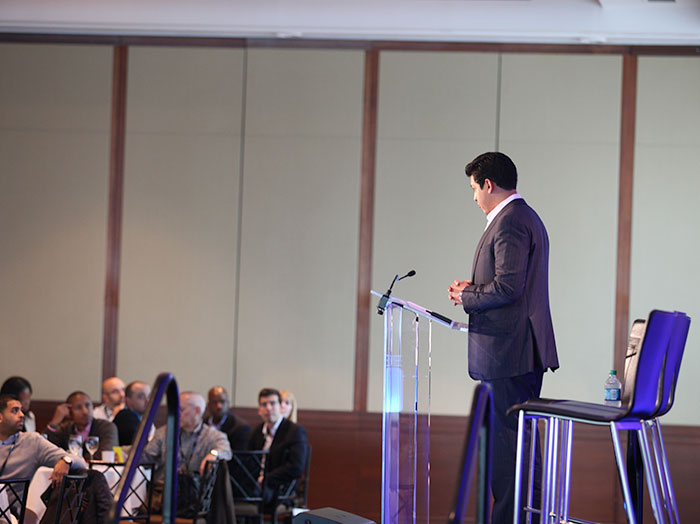 Kirk introduces Carl Fremont, Chief Digital Officer, MEC Global as the moderator for a panel: Evolving Programmatic. Carl introduces panelists: Brian Gleason, MD, North America, Xaxis; Lou Paskalis, SVP, Enterprise Media Executive, Bank of America; Dick Porter, EVP & President of Media Sales, Meredith; Ritu Trivedi, SVP, Digital Strategy and Partnerships, MediaVest, USA.
Kirk introduces Carl Fremont, Chief Digital Officer, MEC Global as the moderator for a panel: Evolving Programmatic. Carl introduces panelists: Brian Gleason, MD, North America, Xaxis; Lou Paskalis, SVP, Enterprise Media Executive, Bank of America; Dick Porter, EVP & President of Media Sales, Meredith; Ritu Trivedi, SVP, Digital Strategy and Partnerships, MediaVest, USA.
Carl ponders, has programmatic lived up to its expectations?
Ritu says the goals have changed as the space changes. Clients ask about it, executives think about. They are trying to build for it and get more talent for it. She says she doesn’t know if they t have a goal as an agency but it is by client. Ritu says from an action perspective, there is a lot of work to be done.
Dick says it is binary option from the sell side. Xaxis’ view is that programmatic has to happen. With the power of first party data, he believes Xaxis can do well.
Carl wonders what Lou’s expectations/goals are as he comes from a different background. As a marketer, Carl is getting inside consumers’ heads. We’re there as an industry with a lowest common denominator end which inherently has a low degree of relevance. The self-actualization of programmatic is how we can link the data stream. He wants to create bespoke ad experiences, permission-based and wants the creative side of the house to catch up to the technical side of the house and provide enough assets to tailor messaging for consumers in a way that creates break-through. Let’s pivot to making our ad assets better – same rails of programmatic to deliver content. He says there is a lot of work to do.
Brian says that when you think about data, programmatic is a great premise. From a tech standpoint, it’s there. The next wave is inventory. From a branding perspective, there is a wealthy of opportunity. At the same time, he agrees with Lou: how we engage in that 1:1 conversation, he doesn’t think we’ve touched. Also, there is analytics.
Carl is wondering what should we expect is the percent of the programmatic trading environment?
Ritu agrees, that we can’t peg a number because when it comes to branding, there is a lot of work. We are swayed by jargon and real-time but we haven’t necessarily put all the right things in place. Programmatic was less about tech 2 years ago and more about data and insights. She thinks somewhere in the last year or two we’ve lost our way and it’s become more about the tech stack.
Dick says there aren’t a lot of markets that perpetually go up – but there is accountability. The consumer expectation is that you’ll deliver more, know more about them and deliver against that value. Dick says he loves consumer revenue. He says accountability is really critical – they are problem solvers. He says the tech stack is not the problem they solve – it’s the agency. He says you he needs to think about how are they going to optimize a household because they believe they should sell stuff that works, and not sell what doesn’t. Dick says programmatic is “just a segment of a solution based that gets a marketer where they need to go.”
Carl asks Dick, will programmatic move Meredith into more sides of their media? Dick says they have great data people but not necessarily great “sales data” people; the talent trails the tech and people will have to pay to get the best and brightest.
Carl wonders what the panelists should do around the talent? How do they recruit, retain, and train in this completely evolving market?
Ritu says, it’s not just about the data, but insights have to be built. These people need to be able to build case studies, business points that actually solve problems for clients. Without this, it’s just data and those who know media, do this well so those people have to be trained. She says data analytics is a center of excellence, not just about dashboards but the ability to work with everyone in this room. The old and new need to work together otherwise silos will be created.
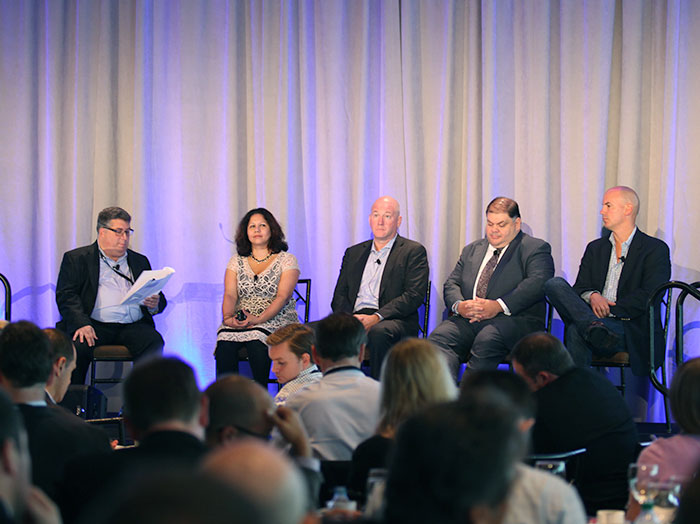 Dick says they are a database marketer disguised as a big media company. The trust that has been given to them by consumers is really important. He says the future is “consortiums.” They work with PubMatic and Krux – for data security and trust.Brian says Xaxis doesn’t necessarily want to participate in open marketplace but rather 1:1 relationships with publishers. He says they found 30% lift over the open market. 1:1 prevents fraud in the marketplace and rewards content.
Dick says they are a database marketer disguised as a big media company. The trust that has been given to them by consumers is really important. He says the future is “consortiums.” They work with PubMatic and Krux – for data security and trust.Brian says Xaxis doesn’t necessarily want to participate in open marketplace but rather 1:1 relationships with publishers. He says they found 30% lift over the open market. 1:1 prevents fraud in the marketplace and rewards content.
Lou says it’s hard in the financial services category to give his data to Dick. As a marketer, there are opportunities to exchange value however the financial services industry wont’ take the lead. He has a vision of the future, we are going to track you and we “screw up, we’ll kill ourselves trying to fix it.” Consumers need to know, what’s in it for them, even if it’s just 5% of the market. He says, this is the future we should aspire to.
Carl asks the panel in a lightning round, “programmatic media = return on blank?” Panelist responses are investment, performance, engagement, and value.
Carl asks the panel in a lightning round, “programmatic media = return on blank?” Panelist responses are investment, performance, engagement, and value.
Carl asks, how do they find talent? Brian, says they first identify the need. “Passion” is the common characteristic. Lou says we have a merchandising problem – we are topics about features rather than benefits. The benefits are what consumers will respond to. We need to get out of optimization mindset for finance and more into the consumer mindset. He wants to attract those types of people.
Brian says Xaxis doesn’t necessarily want to participate in open marketplace but rather 1:1 relationships with publishers. He says they found 30% lift over the open market. 1:1 prevents fraud in the marketplace and rewards content.
Dick says they are a database marketer disguised as a big media company. The trust that has been given to them by consumers is really important. He says the future is “consortiums.” They work with PubMatic and Krux – for data security and trust.
Lou says it’s hard in the financial services category to give his data to Dick. As a marketer, there are opportunities to exchange value however the financial services industry wont’ take the lead. He has a vision of the future, we are going to track you and we “screw up, we’ll kill ourselves trying to fix it.” Consumers need to know, what’s in it for them, even if it’s just 5% of the market. He says, this is the future we should aspire to.
Carl asks the panel in a lightning round, “programmatic media = return on blank?” Panelist responses are investment, performance, engagement, and value.
Kirk introduces the next panel: Ad Tech – The Tool or The Trade moderated by Vikram Somaya, GM, WeatherFX, the Weather Company. His panelists are: Jeff Green, CEO and Co-Founder, The Trade Desk; Eric A. Litman, Chairman & CEO, Medialets; Andy Monfried, Founder and CEO, Lotame; John Snyder, CEO. Grapeshot Limited.
Vikram says uses Shakespearean voice to talk about whether or not to “ad tech.” Vikram asks, how did the panelists know they were going to build what they were as CEOs and Founders.
Vikram asks who are the people here – because of Rocket Fuel IPO? Jeff says he hopes Rocket Fuel continues to do well because it may help the industry.
Andy says people have become so reliant on data for retargeting and that the human API that Rajeev showed is the most underutilized part of the tech stack. He says that Lotame is out there with great technology – he says his differentiator is the people.
John is saying with keyword context, then you are very blind. Grapeshot makes RTB less blind.
Jeff says it’s pretty complicated to talk about agency margins however you have to remember agency trading desks have really healthy margins. He believes they will compress but agencies are constantly looking for ways to make larger margins. Margins will improve because we have to add the human component to the technology discussion. Jeff calls it “the clear box” – let everybody look inside.
Vikram talks about agency consolidation – he wants to know what the future of the centralized trading desk is.
John feels that big agencies have the wealth of data aggregation. He says the biggest margins he sees aren’t from trading desks but from publishers like The Daily Mail from audience extension.
Andy says he takes a different view – coming from the ad network world, ad nets invest a huge amount of money in people. Many marketers often don’t care about getting smarter but rather just on results.
Eric says it’s a systems integrations play. He says, “it’s a leveraged game.” There are companies whose sole value prop was to get smarter about “this” because their margins allow it. Eric says agencies are in a tremendous position to take the knowledge they’ve gained and do more and more with the technology as the direct tech vendor to their clients vs spending time as the filter of the smart people better invested in the tech. Jeff agrees to Eric. Jeff says it won’t be centralized long term but the more important point that there will successful agency trading desks. Agencies are in a phenomenal position because it is in their DNA to add service.
Vikram thinks there are too many ways to target – confusing to publishers, agencies, entrepreneurs. How do we simplify? John says you have to get the capabilities bundled into a workflow. He says context is still not in there. At the end of the day, the publisher has to pull the strands together.
Andy, says the most important thing to understand is how can I leverage my first party data internally and how can I integrate so I am sharing my segments externally. He continues on with talking about the importance of knowing where the publisher should be sending his data and what partners he is integrated with. Andy notes that is what you need to keep CPM’s intact.
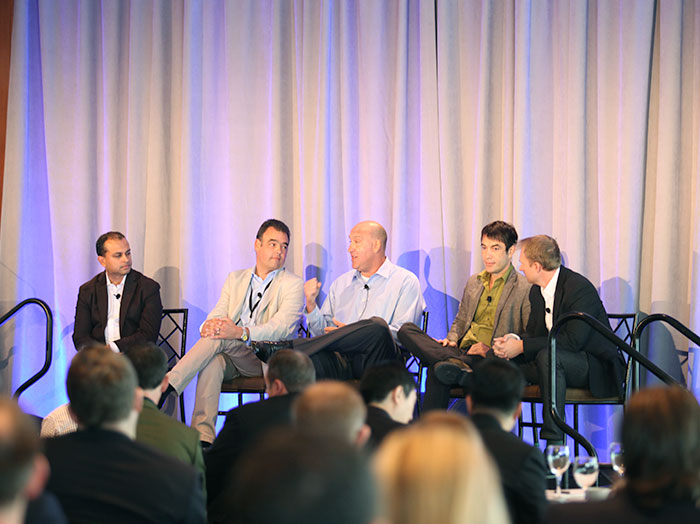 Vikram says looking into the conference theme and looking into the future, asks the panelists for their thoughts re: emotions up as pupils were dilated.
Vikram says looking into the conference theme and looking into the future, asks the panelists for their thoughts re: emotions up as pupils were dilated.
Jeff says it’s a difficult argument to make. Andy says they are skittish about wearable devices because what can be tied to a person/individual v. an audience.
Vikram throws out a bunch of statements and asks for reactions:
- Women and minorities in ad tech boardrooms – should we let them in? Jeff says there is no question we need more diversity in ad tech.
- If you had to choose between glasses or a watch to do everything you want, which one? John says charging device would be the problem. Eric says he has a Pebble and Google Glass.
- Most impactful employee in your team, name and title and why? John says his senior engineer because you have to innovate very fast – Alex. Andy says it is Brian who runs the client success team as he brings back the knowledge regarding what works for the org and not. The people that make Lotame smarter are the key to driving both product and tech. Eric says his best employees are his customers – Vikram says Eric failed. Jeff says it takes a village and no way to identify a single employee.
- The best client interaction you’ve had that stuck out in your memory? Jeff says when the lines between personal and professional get blurred it really highlights how great it is to be in this business. Eric mentions 4 days ago explaining digital marketing to a client’s dad. The practical matter is that we need to help the people who spend money on our category. Andy says he is most proud of that their usage is up 370% from Q1 to Q4.
- When you speak to the next generation, what do you say to them about the experiences you’ve had in this industry? John says the young generation get a lot of this stuff and we have a lot to learn from them and not the other way around. Andy says it’s such a fast paced environment, it keeps you up at night because you don’t know what’s going on. Everyone thinks there is a knowledge gap and you’ll never know anything but it’s exciting. Eric says use your intuition and be audacious. Jeff says understand the core of the business for example, trafficking – because if you understand the core, you’ll be able to do anything. Now we go to break for refreshments! EmbraceLED will light up. See you soon!
Kirk introduces Reggie Lau, Total Economic Impact Senior Consultant, Forrester Research. This study, is an update on last year’s TEI study which demonstrated lift in eCPM and sell-through using RTB and PMP.
Congrats on the engagement Reggie!
Stay tuned – technical difficulty!
Okay we’re back! Reggie summarized, “PubMatic generates incremental ad revenue, sets foundation for programmatic sales, and puts mobile monetization in motion. Over three years, after adjusting for risk, the financial impact PubMatic has on LaudNet (a composite organization was comprised of 4 PubMatic customers) is ROI: 338%, NPV $6MM+, and payback <1 month.
Benefits were:
- In open market RTB revenue, 35-50% CPM lift with 90% discretionary inventory monetized.
- In private marketplace revenue, 4x lift on top of RTB CPM lift
- For mobile monetization, it was still early days for LaudNet but there was high potential
- Brand value retention
- Relationship management efficiency; realigned 2 of 6 resources to support programmatic
Thanks Reggie!
We now welcome Doug Weaver, Founder & CEO, Upstream Group to moderate the panel: The Private Marketplace Opportunity. Panelists include: Megan Pagliuca, GM & VP of Display Media, Merkle; Vincent A. Paolozzi, Sr. Director, Marketplace Development, Cadreon; David Rowley, VP Revenue Operations, BlogHer; Matt Spengler, Executive Director, Digital Sales, Rodale, Inc.
 Doug asks what is exactly for sale in a private marketplace? Vincent says it’s rich contextual environments and audience based opportunities.
Doug asks what is exactly for sale in a private marketplace? Vincent says it’s rich contextual environments and audience based opportunities.
Doug wonders what is actually being transacted in a private marketplace? David says it can take a lot of different permutations. He says you start with 1 deal ID, which is RON. Doug confirms, initially a pilot program: a store you want to buy at.
Doug asks Matt to give a different read on it: Matt says it’s endemic and non-endemic. The other might be core advertiser like Nike who wants to test programmatic – could be run of Rodale, run of women’s sites, perhaps based on past experience.
Doug asks for audience participation – raise your hand if you’re still confused about private marketplace. 1 person raised his hand.
Doug talks about truly private marketplaces and semi-private marketplaces. Megan says they care about being higher in the prioritization chain whether it’s private and semi-private. Vincent says there a number of variables – collaboration between the buyer and the seller. You have to know what the needs of the buyer are. It could be as broad as run of network or as direct as your autos channel.
Doug asks Vincent to pick a brand and Vincent chooses MasterCard. Doug asks, what leads you to want to do a private marketplace deal in the first place? David looks at it advertiser by advertiser. He says this advertiser has been hard to break into. There would be more opportunity to work with an advertiser like MasterCard on programmatic.
Doug says he hears more and more big advertisers wants to do direct with you but we want our data involved in the programmatic space. Our marketers dictating terms? Megan says agencies are dictating it.
Question: if I do programmatic work with you, can I also get direct business?
Megan can make that call as an independent planning agency. Doug says publishers were leery about the idea of jumping into the big demand pool of the open exchange. The question was, am I cutting myself off from direct sales? Or am I discounting my business?
Megan says the publishers who’ve had the most challenges are the ones who’ve tried to protect cannibalization. Publishers have to embrace it otherwise dollars will go to another publisher. Doug confirms the message is don’t be scared, embrace it, or keep your head in the sand and do nothing.
Matt is saying that programmatic can lead to print deals – exception but not the norm but it is a bit of separate business right now. To Megan’s point, you have to be involved and be smart about it.
Doug wonders how a private marketplace arrangement actually happen? Does the role of the outside seller; do they have a role? Matt says they don’t at this point but it’s not the main lead source. Some come from the open market.
Questions: what should every seller know about programmatic/private marketplaces to help move this along? Megan said they’ll go through the SSP’s, make sure they’re talking to the right person. Doug says you’ll use PubMatic as the filter. Megan says yes because PubMatic will introduce you to the right person.
Doug looks at the audience for questions: how important are deal ID’s in these arrangements? Are they simplifying or complicating the process? Megan and Vincent agree they are important and there are still challenges but they are getting better and the mechanism for transaction.
Another question from the audience, “How important is it for a publisher to be able to break out site into section rather than audience?” Matt says they aren’t a giant portal so they have to be more careful about it and they go with more general categories. David says he keeps it broad as well – food, parenting, fashion, etc. Some of those categories don’t scale but gives buyers testing opps.
Vincent agrees that you have to start broad and then break it down on a client by client basis. Megan says she will be more tactical and operational: NBC has done a good job of this. Merkle will start broad but depending on the cannibalization concerns, you should decide.
Doug milks his last 2 minutes and wants panelists to offer 1 hard fact for the audience:
Matt: private marketplace opps are here to stay, get involved in the process.
David: Go all in because it’s here to stay, if you’re going to have your salespeople to sell, make sure it isn’t devalued, a dollar is a dollar.
Vincent: Get connected, get really smart around how do you utilize data and analytics.
Megan: Create differentiation with your first party data; use your social login.
Thanks Doug and panelists! And now we break for lunch catered by Abigail Kirsch!
Kirk welcomes the audience back from lunch. Thanks the Trade Desk for sponsoring!
We are very fortunate today to have the CEO of AOL Networks, Bob Lord to give the Keynote: CONVERGE – Transforming Business at the Intersection of Marketing and Technology.
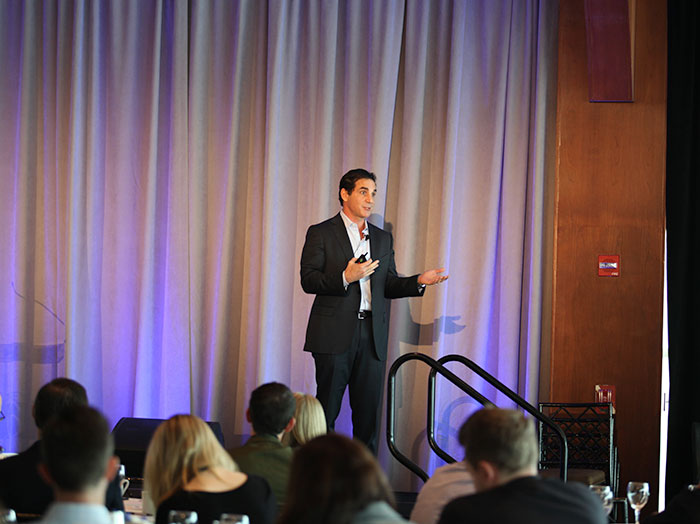 Bob says there is a fundamental business problem, it is completely inefficient. There is no reason why we can’t buy the way we transact in commerce. This is why Bob came to AOL. Bob fundamentally believes in order for any industry to transform itself, it has to converge, it has to think about its business in a different way. Bob co-wrote the book “CONVERGE.” The reality is in the media world, the consumer got a voice. Bob says “creativity can come from anywhere.”
Bob says there is a fundamental business problem, it is completely inefficient. There is no reason why we can’t buy the way we transact in commerce. This is why Bob came to AOL. Bob fundamentally believes in order for any industry to transform itself, it has to converge, it has to think about its business in a different way. Bob co-wrote the book “CONVERGE.” The reality is in the media world, the consumer got a voice. Bob says “creativity can come from anywhere.”
He ponders how do we bring tech, media/data, creativity together? He says from a creative standpoint, “we’ve been coloring it black and white.” He goes back to Henry Ford – the auto industry in the 1900’s, Henry Ford created the assembly line. When the Model T hit the auto industry, there were finally scalable solutions. Look at finance: trading automation – we got rid of the mundane tasks. The reality is where we’re moving from feature companies to platform companies – he calls it ” The Technology Tax.” We’ve got to make the ecosystem much more efficient for us.
There are 4 trends to embrace:
- Put the customer at the center – We’re not asking the right question, how do we provide more value, and together?
- Think of a brand as a service
- Reject silos
- Act like a startup and embrace diversity
Bob says:
“Campaigns Must Be Structured Around the Customer”
“Strategies MUST Be Based on Data from Actual Customer Activity” – the micro behaviors of tribes is going to be profound. We have to use technology to get there.
“Brands are no longer in the business of selling stuff, they’re filling consumer needs”
Bob, talks about the “Special K” diet. Bob says there is a whole bunch of information that Special K will get because they are mixing a product with a service. The emphasis of getting the basics done – the efficiency between the demand and supply side and now layering on more information on top is where brands are going to go. If you are going to survive as a brand, you have to do more than sell products.
Bob says he could never sell ads based upon device usage without tech and algorithms and it will get more complex. If you start overlaying behavior, context, demo makes the value equation much more complex and brands will demand it.
Bob, shows his Programmatic Brand Platform:
1a) Consolidate
1b) Onboard
2) Standardize Measurement
3) Plan Intelligently
4) Execute Programmatically
5a) Measure ROI
5b) Get Smarter
We now get into a Q&A between Bob and Larry Harris, CMO of PubMatic.
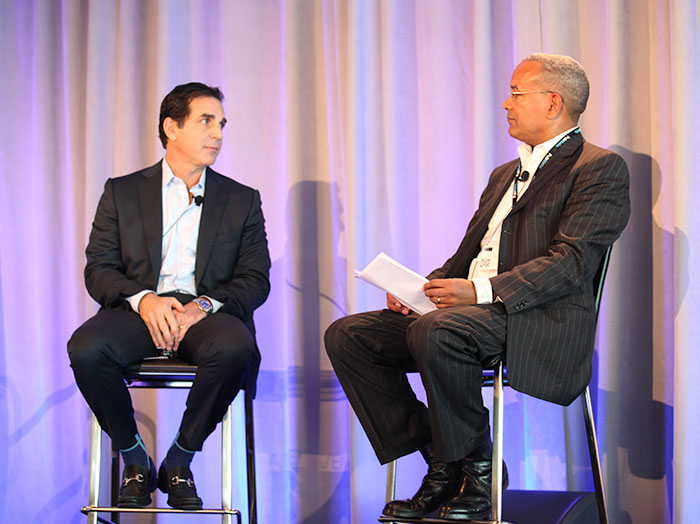
- Why this shift in roles? Bob wanted to recreate the magic of Aquantive, the economics of services doesn’t allow him to build the platform/product around programmatic and try to solve the problem. He mentions he doesn’t think we’re all on the same page of what the problem is.
- How as a publisher are you helping to solve the problem with agencies?The agency world has a lot of influence over brands. Bob is imploring the room to help solve the problem of margins. The publisher has to go lock-step with the agencies because the last thing the creative agencies want to do is spend more money on media.
- What his Bob’s definition of programmatic? Bob says “automation which is not synonymous with RTB.” We need to avoid the race to the bottom.
- Giving television a run for its money…why now? The response Bob got to a programmatic upfront and to try to get them to understand is to give them money back to throw into creativity. Bob says the requests have been beyond his expectations. Bob says when you look at the AOL stack, they need partners to help them accomplish their goals.
- What important does Bob see around creative? Bob thinks you should learn to code as a creative person. The challenge of creativity is much more complex than ever before. You need more creative and talented people than ever before. He mentions that his son doesn’t know the difference between a creative department and a tech department.
- What’s happening Q4?
- What has surprised Bob in 2000 from where he stands in 2013? Bob says he knew tech was going to have an impact on the industry but didn’t realize how reticent we would be as an industry to embrace it.
Kirk intros the next panel: Cross Platform Becomes Reality – Taking Mobile to the Next Level. The moderator is Rick Mandler, VP, Digital Advertising Sales & New Media, ABC Television Networks and his panelists are: Mike Baker, Co-Founder & CEO, DataXu; Michael Collins, CEO, Adelphic; Kamakshi Sivaramakrishnan, Founder & CEO, Drawbridge, Inc; Are Traasdahl, CEO & Founder, Tapad; Elizabeth Zalman, Co-Founder & CEO, Media Armour.
Rick says, why do we care about cross platform? Are says, “the holy grail of advertising.” Michael says consumer are multi-channel and brands need to be multi-channel. Rick wonders if there is a danger in looking at the world by way of “half my advertising is wasted.” Do we risk more if we hyper target and data drive customers who aren’t ready yet?
 Rick asks, how real is the risk of government intervention undermining operations today? How can we manage this so consumers don’t feel the “ick factor” – that big brother is watching them? Mike says it requires industry buy-in.
Rick asks, how real is the risk of government intervention undermining operations today? How can we manage this so consumers don’t feel the “ick factor” – that big brother is watching them? Mike says it requires industry buy-in.
Rick says as Elizabeth does 1:1 conversations with customers, is there a tipping point where there is too much information going into the commercial conversation? Elizabeth says yes people do feel this and general branding can be the followup instead.
Rick wants to know, for cable networks, when inventory is sold out, part of the impetus for programmatic sales is that there is liquidity. If that’s the case, will that hinder the growth of programmatic? Mike thinks so.
Rick asks one last question: what keeps him up at night is that as a publisher, he is outside of the demo so he’s not particularly valuable but to an advertiser, he is in the market for a car so he is valuable to an advertiser. This “information asymmetry”: how to resolve?
We move on now to a conversation with Steve Mills, SVP & Group Executive, Software & Systems, IBM Corporation. Interviewing Steve is Michael E. Kassan, Chairman & CEO, Medialink LLC. The conversation is a round “Big Data: Marketer’s Dream or Dilemma?”
Steve talks about the explosion of data and real world events such as 6b mobile phones worldwide, >24 Petabytes of data that Google processes in a day, etc.
Steve says, “80% of all available data will be uncertain.” If money is spent to collect it, how do you get value out of it?
He continues by talking about how big data and analytics matter; Use cases he mentions are big data exploration, enhanced 360 degree view of the customer, security/intelligence extension, operations and analysis, and data warehouse management. The use in advertising/marketing is audience optimization, channel optimization, ad yield optimization, and targeted media buying.
Marketers/advertisers are facing big data challenges – mainly in processing of the data as well as ongoing management and analysis.
Steve shows various case studies that show how customers who used IBM analytics software to measure ad effectiveness had improved customer response rates, reduced analytics time, improved ROI, etc.
Steve winds down his presentation by talking about how IBM’s investment in big data and analytics continues to rise.
 We welcome Karsten Weide, Program Vice President, Media & Entertainment, IDC to the stage. Karsten says, last year we spent 1/10 in RTB. This year 11%. By 2017, 28% will be through RTB platforms.
We welcome Karsten Weide, Program Vice President, Media & Entertainment, IDC to the stage. Karsten says, last year we spent 1/10 in RTB. This year 11%. By 2017, 28% will be through RTB platforms.
There is no segment in online advertising growing faster than RTB. 2012-2017 CAGR: 22% video, 39% mobile, 51% RTB.
The overlap between mobile and RTB creates tremendous business opportunity. The fast majority of the spending is happening in the US. Most markets are much more conservative than the US. Japan’s numbers are smaller than Western Europe however it is just one country.
China is just beginning with RTB: infrastructure issues because ideal time frame is 30 milliseconds and networks are too slow. Most inventory in China isn’t being sold (80%). If you look at the culture of the ad industry in China, it is 2-4 years behind.
A lot of sales are on a time basis. Australia is fairly advanced in terms of RTB but market is small so not a whole lot of spending there. The major source of growth will be indirect sales.
Video will be a minor contributor on overall revenue because there isn’t enough inventory to go around. The inventory that is available is being sold direct. Mobile sales and direct sales were be more important than indirect sales.
This year 60% of indirect sales will be done via RTB. By 2017, it will be over 80% with RTB.
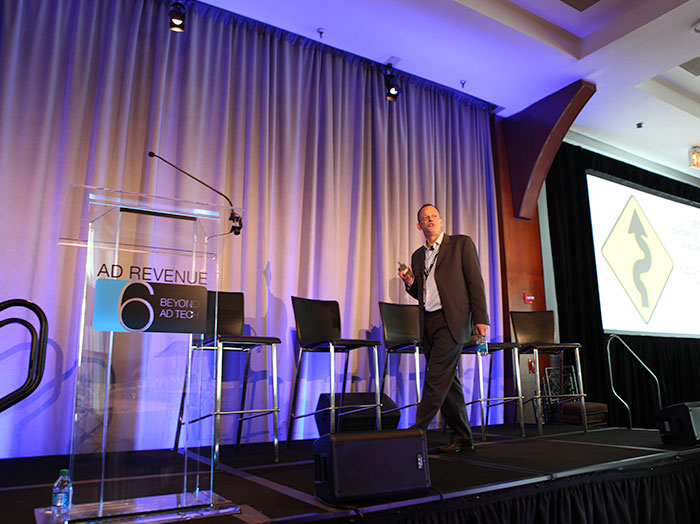 Karsten mentions when it comes to mobile RTB, if you look at overall relationship between online and mobile, the industry feels mobile is still a new thing. Karsten says mobile will “crush” online in the future.
Karsten mentions when it comes to mobile RTB, if you look at overall relationship between online and mobile, the industry feels mobile is still a new thing. Karsten says mobile will “crush” online in the future.
Karsten said the commercial significance of private marketplace is minimal. The reason why is it is because it is an exchange and they only work well where there is liquidity. A private marketplace artificially reduces the liquidity. What they will continue to do is “allow publishers to stick their toes into the water, without being afraid to drown.”
Guaranteed upfront, programmatic premium, etc. he says are what’s coming for direct sales. What happens if a publisher defaults on these guarantees? Karsten mentions contractual default obligation.
Why do we think direct sales will take off in a big way? Agencies want it because it is effective. In indirect sales, publisher defaults, platform defaults, advertisers and agencies get their money automatically. Publishers will embrace RTB for “survival.”
Karsten says “it’s time to take a closer look at RTB” and “RTB is your friend.” With automation, there will be fewer salespeople, but “it is what it is.” Sales has to be more consultative, more about native executions, and a more interesting/challenging job in the future.
Karsten’s final thoughts: “closing the feedback loop.” When someone figures out how to do this on scale, it will be very hard to compete with RTB.
Thanks Karsten for a very interesting look into the industry’s future.
In the final panel today: How the Role of the CRO Has Changed in a Programmatic World, moderating is Michael Barrett, President, Ichabod Farm Ventures. Panelists are Jeff Dossett, CRO, Demand Media; John Henderson, SVP, Sales, Answers Inc; Ann Lundberg, SVP, Digital Sales, Food & Cooking, Scripps Networks Digital; Rich Sutton, CRO, North America, Mail Online; Lisa Valentino, SVP, Multimedia Sales, ESPN.
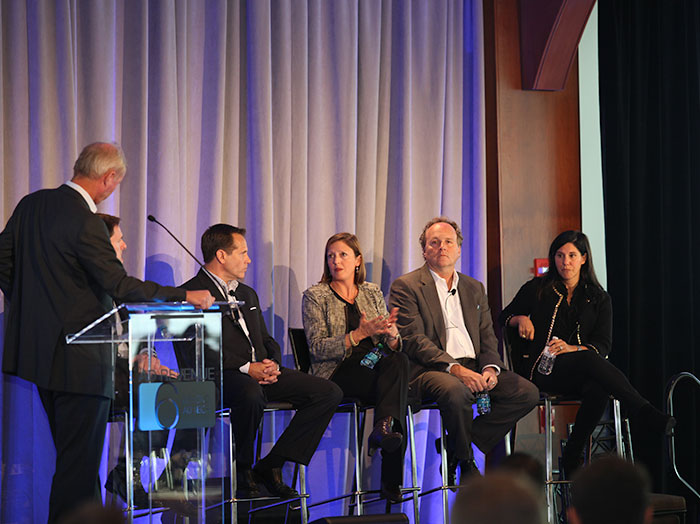 Michael asks Lisa, how is ESPN structured? Lisa says that they are matrixed – they have specialists that work with trading desks but they aren’t looked at programmatic separately.
Michael asks Lisa, how is ESPN structured? Lisa says that they are matrixed – they have specialists that work with trading desks but they aren’t looked at programmatic separately.
Michael looks to Ann to discuss programmatic at Scripps. Ann says at Scripps, they are TV driven. They have a programmatic leader who tries to build high-level relationships with DSPs and trading desks.
Michael asks if programmatic is amounting to real dollars? Ann said it’s gone 0-30 in 1 year. It’s a big focus for Scripps.
John says that Answers.com may be the biggest site people haven’t heard of. He is in a unique position to start the direct ad sales team. 95% of his revenue today is through the open exchange. He was brought on board to take it up a notch on the private marketplace.
For Demand Media, Jeff says the brand marketer & agency are their customers – that hasn’t changed. They haven’t restructured.
Michael asks how do you arm the direct sellers? Lisa says define what you mean by programmatic. This is not a CPM game. If it were, ESPN would not be in the programmatic space. Today most of the sector is in the ad network space. If we look at this as automationthen we can focus on our business.
Rich says you have a brand and a solution proposition. If you can’t get that across, it doesn’t mater if it comes across an IO or programmatically.
Jeff says that trying to fight logical trends, makes no sense. To the extent there is cannibalization, we were asking of the market to pay a price above the real value of that product or service, shame on us. He continues on to say, we over-complicate this.
Michael says the real challenge is to manage for today but also planning for the future – “who wouldn’t want a more automated world?”
John says that at TripAdvisor where he was for 6 years, he didn’t spend much time thinking about programmatic. Now he is doing a 180 and it’s more about the advertisers they speak to and what their goals are and their plans are. From his perspectives, listen to advertisers and give them more.
Jeff says he looks forward to the opportunity of unlocking value of audience he can’t yet put through programmatic. Lisa says in the mobile space for her category, the mobile screen is likely the first screen. She’s seeing the revenue start to follow and yet there is a surge of mobile conversation happening but you can’t unlock the value yet. The low CPM business is accelerating so they have not exposed mobile and video to programmatic until they believe the environment provides the value.
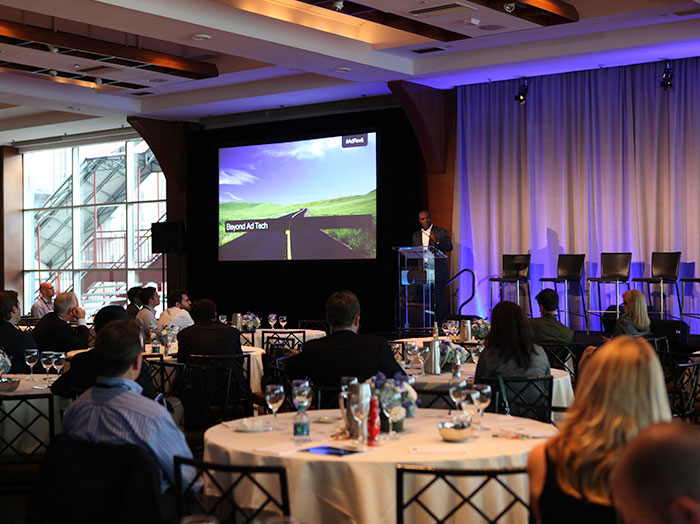 Kirk finishes the presentations with closing remarks and talks about why the theme of the day was “Beyond Ad Tech.” He mentions that the principals of advertising are regaining control, recapturing value, and focusing on long-term growth strategies.
Kirk finishes the presentations with closing remarks and talks about why the theme of the day was “Beyond Ad Tech.” He mentions that the principals of advertising are regaining control, recapturing value, and focusing on long-term growth strategies.
Thanks to all our speakers, moderators, panelists, attendees, and sponsors! It’s cocktail hour!
Cindy Lee @iamcilee, PubMatic
